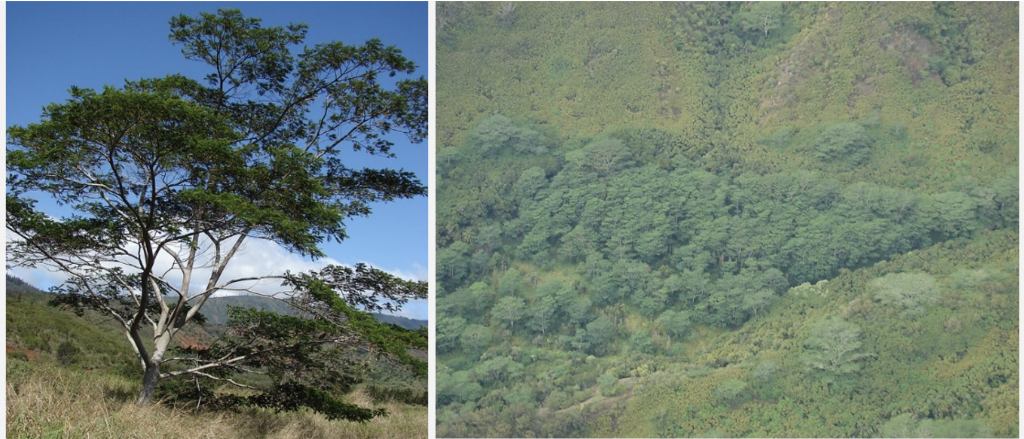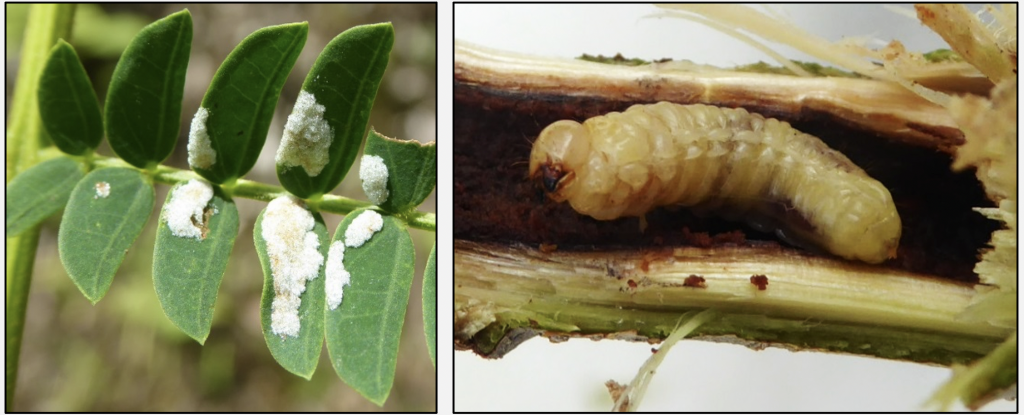THE TARGET: Albizia (Falcataria moluccana)

An individual Albizia, left, and a large uniform stand, right. ; Photos by Forest & Kim Starr
- Potentially the fastest growing tree in the world, Albizia (Falcataria moluccana) is one of the most noticeable invasive species in Hawaiʻi. These large trees, up to 150 feet tall, can grow 15 feet per year and quickly outcompete and displace entire Hawaiian forests. Albizia also increases soil nitrogen levels, which alters an entire ecosystem and changes growing conditions, further creating an environment that benefits some invasive species over native flora.
- While Albizia grows quickly, its wood is very weak and prone to limbs and/or entire trees breaking and falling over. Trees pose a serious hazard to all human structures, including homes, power lines, and highways. Management is extremely costly, as removal of hazardous trees can cost thousands of dollars per tree.
- Distribution: Native to parts of Indonesia and Papua New Guinea, Albizia is currently widespread on Kauaʻi, Oʻahu, Maui, Hawaiʻi Island. It is known from small populations on Lanaʻi and not known on Molokaʻi. Albizia infests other pacific islands especially lowland humid forests on Pacific and Indian Ocean islands.
THE CANDIDATE(S):

Early potential natural enemies of Albizia: an eriophyid galling mite, left, and a stem boring weevil, right.
- Exploration for potential biological controls began in 2015. The US Forest Service has collaborated with both IPB University and Pattimura University in Indonesia to sponsor exploratory trips to Albizia’s native range, currently focused in Moluccana.
- Early explorations have collected many species of leaf beetles, longhorn beetles, weevils, and other invertebrate groups found to feed on Albizia.
- Multiple species have been studied, but two potential candidates, a leaf galling mite and a stem boring weevil, were prioritized for future study in 2019. Observed life histories of the mite and weevil suggest they may be narrowly host-specific, but no testing has been completed yet. The mite is likely in the genus Adenocolus and the weevil likely in the genus Solobrachis, but further genetic testing is necessary.
TIMELINE OF PROJECT PROGRESS:
- The project is in the exploratory phase; researchers are determining suitable natural enemies for Albizia.
- Two early candidates show potential, but more exploration is needed, and host specificity testing has not started. Travel restrictions due to COVID are currently postponing the projected timeline.
- The large size of albizia trees may lead to logistical problems in testing. New facilities would help address that issue.